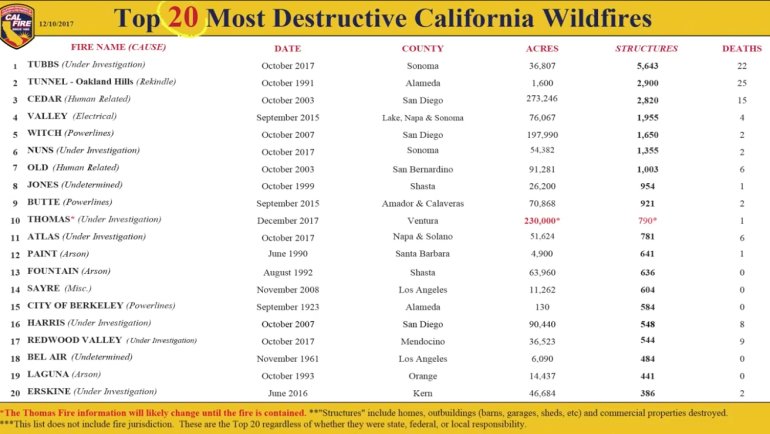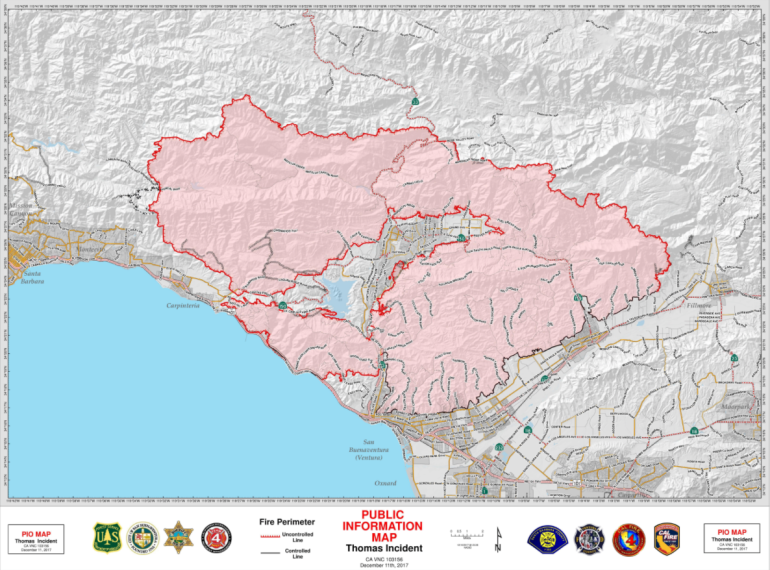Five of California’s most destructive wildfires in modern history have occurred in 2017, and the still-burning Thomas Fire is the 10th most destructive so far, a Cal Fire spokesman said Monday.
The 360-square-mile blaze, now the fifth-largest fire by acreage in state history, is continuing to rage and threaten some 18,000 homes in Santa Barbara and Ventura counties. The fire has burned nearly 800 structures since it ignited in Santa Paula on Dec. 4.
Statewide, more than 10,000 structures have been destroyed so far this year, Cal Fire Capt. Scott McLean said in the department’s daily “fire situation report” Monday.

In the last week, the six wildfires that burned in Southern California have destroyed more than 1,400 structures.
Those numbers will go up as damage inspection teams work on the still-raging Thomas Fire, McLean said.
The Tubbs Fire, which destroyed more then 5,600 buildings in Sonoma County in October, is the most destructive blaze in state history. Its sister blaze that burned nearby, the Nuns Fire, took down 1,355 structures.
“These numbers reflect a major shift in wildfires, one we have seen over the past 10 years,” McLean said. “Wildfires are becoming more damaging and destructive.”
Last week’s weather conditions – which included wind gusts of more than 80 mph – are improving. But Santa Ana winds are still blowing and Southern California remains very dry, and that will push continued growth of the Thomas Fire, the captain said.
“We don’t even call it fire season anymore. Take the ‘season’ out – it’s year-round,” McLean said.

At a weekend news conference in Ventura, Gov. Jerry Brown pointed the finger at climate change, calling the threat of damaging wildfires the “new normal” for California.
“We’re facing a new reality in this state where fires threaten people’s lives, their property, their neighborhoods, and of course billions and billions of dollars,” Brown said. “We have to have the resources to combat the fires and we have to also invest in managing vegetation and forests, and all the ways we dwell in this very wonderful place, but a place that’s getting hotter.”
No precipitation is predicted statewide for the rest of 2017, McLean said.
We don't like to stretch limits of computer models, but we really need some precipitation in our future. This stubborn high pressure ridge (current – left) doesn't budge thru X-mas (right)! Stronger than ever from Alaska & down west coast. #ThomasFire #CAwx #SoCal pic.twitter.com/mHJJS5hCnd
— NWS Los Angeles (@NWSLosAngeles) December 11, 2017
One of the many culprits behind our large fire potential recently. Hardly any rainfall so far this water year across most of #SoCal, and it's not looking very promising in the next two weeks either. #drought #LAWeather #CAwx pic.twitter.com/2ysSsifQwc
— NWS Los Angeles (@NWSLosAngeles) December 8, 2017